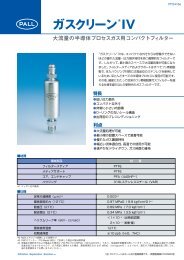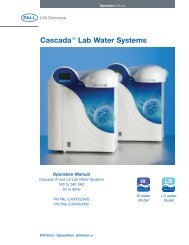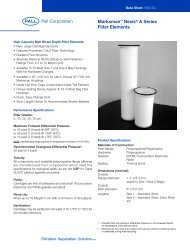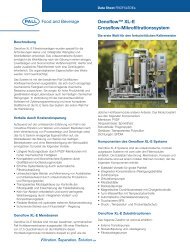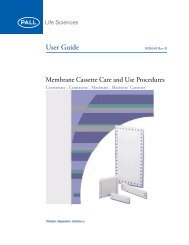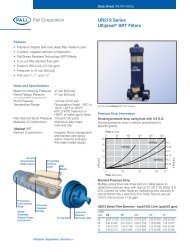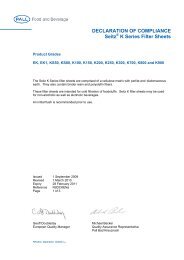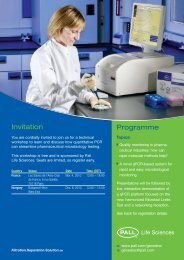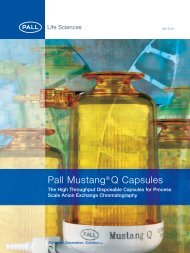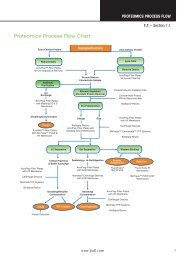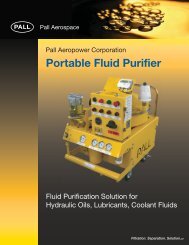Prod Insert 290128 MEP HyperCel A3.qxp - Pall Corporation (PLL)
Prod Insert 290128 MEP HyperCel A3.qxp - Pall Corporation (PLL)
Prod Insert 290128 MEP HyperCel A3.qxp - Pall Corporation (PLL)
Create successful ePaper yourself
Turn your PDF publications into a flip-book with our unique Google optimized e-Paper software.
- Check the pH and the conductivity of the feedstock. If it is between6.5 and 9.5, no adjustment is necessary. Diafiltration, concentration ordilution are not typically required. Load feedstock onto column.- Wash the column with 50 mM Tris-HCl, pH 8, until UV absorbancereturns to baseline (1-4 cv). Other buffers may be used.- Elute bound antibody using a dilute buffer at pH 4. Buffers typicallyused include 50 mM sodium acetate or 20 mM sodium citrate (2-4 cv).DBC at 10% breakthrough(mg/mL)ApHNaCl (M)Figure 3. Influence of pH and ionic strength on the binding capacity of <strong>MEP</strong><strong>HyperCel</strong> sorbent. IgG capacities obtained at 10% breakthrough on <strong>MEP</strong><strong>HyperCel</strong> sorbent vs. pH (A) and ionic strength (B) of the binding buffer.Experimental conditions: Column 1.1 cm (0.4 in.) ID x 9 cm (3.5 in.); Sample: IgG (2mg/mL); Flow rate: 90 cm/h.NOTE - Elution optimization:A step-elution sequence using buffers of decreasing pH (e.g. 5.5,5.2, 4.9, 4.6, 4.3, 4.0, 3.0) is recommended. Buffers typically usedinclude 50 mM sodium acetate or 20 mM sodium citrate. Elution ateach step should be continued for 2–4 cv, or until complete elutionof an observed peak is accomplished. Based on analysis ofcollected fractions, a second step-elution experiment at narrowerpH increments or at alternative values may be useful.Ultimately, the elution procedure would be simplified to a three-stepsequence. At the highest pH, elution of basic impurities would beaccomplished. At the optimized, intermediate pH, the target proteinwould be recovered. At the lowest pH in the sequence, acidicimpurities, aggregates and mis-folds would emerge. Depending onthe characteristics of the acidic and hydrophobic impurities, this finalstep may be conducted at pH 3.0. It is useful to conduct a finalwash at pH 3.0 to prompt desorption of any remaining impuritiesbefore the column is cleaned using sodium hydroxide.- Regenerate the sorbent with 0.5–1.0 M sodium hydroxide for 30 to 60min.As with all chromatographic procedures, varying degrees ofoptimization will be required to account for variation in feedstockcomposition.Protein-free cell culture supernatantSpecific recommendations for an optimal use:- The synthetic iron carriers present in protein-free cell culture mediamay cause the sorbent to take on significant brown color during loading.If this occurs or if IgG recovery is low, 10 mM Na 4 EDTA may be addedBto the feedstock to reduce iron complex formation. Use an EDTA stocksolution (~200 mM, pH 8.0 ). 200mM sodium citrate may alternatively beused. See "Cleaning" section for additional information.- If feedstocks are concentrated (e.g. UF/TFF) prior to column loading,high molecular weight iron carrier, often present in protein-free cellculture media, can aggregate and accumulate on the retentate side ofthe UF/TFF membrane. Such aggregates can bind strongly to <strong>MEP</strong><strong>HyperCel</strong> and lead to column fouling. The addition of 10 mM Na 4 EDTAto the feedstock prior to concentration will limit the accumulation ofthese aggregates. Use an EDTA stock solution (~200 mM, pH 8.0).- Tween* and Triton* should not be included in feedstock or buffers.Such surfactants can interfere with the binding of protein to <strong>MEP</strong><strong>HyperCel</strong>.- Lipid supplements added to the culture medium may compete for the<strong>MEP</strong> ligand, fouling the sorbent and reducing binding capacity. Contactour technical service for assistance.Albumin-containing cell culture supernatant- The sample is loaded directly, without preliminary diafiltration orconcentration.- To desorb bound albumin, additional wash steps are recommendedprior to elution. Following the load and the wash with 50 mM Tris-HCl,pH 8, the column is washed first with pure water, followed by 25 mMsodium caprylate in 50 mM Tris-HCl, pH 8. Continue all washes until UVabsorbance returns to baseline (~2 cv).Ascites fluid, colostrum or other crude, viscous feedstocksEmploy the protocol described above for albumin-containingfeedstocks. Dilute viscous feedstocks with equilibration buffer. Ascitesfluid is typically diluted with an equal volume of buffer. More viscousfeedstocks may need to be diluted with 5–10 volumes of buffer.Cleaning and maintenanceIn order to avoid frequent regeneration, it is advisable to introduce intothe column only samples and buffers that are clear and previouslyfiltered (0.22 μm). Make sure that changes in pH and ionic strengthduring elution do not cause precipitation of sample components. Thefollowing regeneration procedures are recommended for general andspecific cleaning challenges:SituationGeneral Cleaning-In-Place(CIP).Adsorbed contaminants.Presence of iron and ironcarrier, lipids, surfactants.RecommendationWash with 0.5-1 M sodium hydroxide,30-60 min contact time.Wash with 6 M guanidine (2-3 cv) or 2 Murea.See specific part on "protein free cellculture supernatant" above.If you are working with protein-free cell culture media and the additionof EDTA to the feedstock is not feasible, sorbent performance can bepreserved by use of an EDTA solution during cleaning. Followingantibody elution, and before the column is washed with NaOH, wash thecolumn with 100 mM Na 4 EDTA (adjusted to pH 7.2). Alternatively,200 mM sodium citrate, pH 3.0, may be used.IMPORTANT: When using NaOH during the cleaning-in-placeprocedure, <strong>MEP</strong> <strong>HyperCel</strong> sorbent may become coloured. This doesnot affect the chromatographic performance of the sorbent and is dueto the cyclic group on the 4-Mercapto-Ethyl-Pyridine ligand.Thermal Stability and StorageTemperature of useShipping temperatureStorage temperatureStorage solutionCautionOrdering informationSize5 mL25 mL100 mL1 L5 L10 LPart Number12035-06912035-01012035-02812035-03612035-04012035-0442 – 30°C (36 – 86°F)Ambient2 – 8°C (36 – 46°F)Neutral buffer containing 1 M NaCland 20% (v/v) ethanol.Must never be frozenAvoid long exposure to lightNew York - USA+1 516.484.5400 phone+1 516.801.9548 faxpharmafilter@pall.comPortsmouth - UK+44 (0)23 9230 3303 phone+44 (0)23 9230 2506 faxBioPharmUK@europe.pall.comCergy - France+33 (0)1 34 20 78 00 phone+33 (0)1 34 20 78 78 faxbioseprainfo@pall.comVisit us at www.pall.com, <strong>Pall</strong>, BioSepra, <strong>HyperCel</strong>are trademarks of <strong>Pall</strong> <strong>Corporation</strong>.Filtration. Separation. Solution. is aservice mark of <strong>Pall</strong> <strong>Corporation</strong>.Triton is a trademark of a subsidiaryof The Dow Chemical Company.Tween is a trademark of ICIAmerica, Inc.® indicates a trademark registeredin the U.S.Please contact <strong>Pall</strong> BioSepra to getthe instructions in your language.© <strong>Pall</strong> <strong>Corporation</strong> 2005-200702/2007BioSepra <strong>MEP</strong> <strong>HyperCel</strong><strong>Prod</strong>uct Description<strong>290128</strong><strong>MEP</strong> <strong>HyperCel</strong>Hydrophobic Charge InductionChromatography (HCIC) Sorbent<strong>MEP</strong> (Mercapto-Ethyl-Pyridine) <strong>HyperCel</strong> sorbent is a highcapacity, high selectivity sorbent specially designed for thecapture and purification of monoclonal and polyclonalantibodies.<strong>MEP</strong> <strong>HyperCel</strong> sorbent supports efficient capture andpurification of antibodies from a broad range of sources,such as animal sera, ascites fluids and cell culturesupernatants. A variety of cell culture formulations arereadily accommodated, including protein-free, albuminsupplementedand serum-supplemented media. In contrastto Protein A sorbents, IgG binding capacity on <strong>MEP</strong><strong>HyperCel</strong> sorbent is essentially independent of subclass orspecies. "Weakly-binding" variants (e.g., murine IgG 1 , ratIgGs) are well retained.<strong>MEP</strong> <strong>HyperCel</strong> sorbent can also be an excellent alternativeto traditional HIC sorbents for capture of hydrophobicmolecules which are non antibody proteins, or for impurityremoval.<strong>MEP</strong> <strong>HyperCel</strong> provides significant benefits at bothlaboratory and process-scale.• Sample preparation is reduced to clarification:- Feedstock may be applied without adjustment. Bindingoccurs at neutral pH and is independent of ionic strength.No need to add lyotropic or other salts.- Concentration of dilute samples is not necessary.Efficient capture is achieved even with feedstocks as diluteas ~50-100 μg IgG/mL.• Rapid and efficient sample processing:- Large volumes of sample can be processed rapidly andefficiently. Dynamic binding capacities 20 mg IgG per mLof sorbent (at 10% breakthrough) are routinely achieved.- High purity in one step. <strong>Prod</strong>uct purities of 70-90%, orgreater, are typically achieved.- Gentle elution reduces the risk for antibody aggregation.- No need for extensive desalting/diafiltration followingHCIC. In contrast to traditional hydrophobic interactionchromatography, the IgG fraction isolated using <strong>MEP</strong><strong>HyperCel</strong> sorbent is recovered in low ionic strength buffer,and can be applied to an ion exchange column withoutextensive desalting.6 7 8 1
BioSepra <strong>MEP</strong> <strong>HyperCel</strong><strong>290128</strong> - 02/2007• Chemically stable to base:Easy long term cleaning with 1 M sodium hydroxide gives thismaterial a significant advantage over Protein A-based sorbents.PropertiesParticle size80 – 100 μm (av.)Bead compositionHigh porosity cross-linked celluloseDynamic binding capacity forhu IgG (10% breakthrough)* 20 mg/mLLigand4-Mercapto-Ethyl-Pyridine (4-<strong>MEP</strong>)Ligand density80 – 125 μmol/mLAdsorption pH 7.0 – 9.0Elution pH 4.0 – 5.8Cleaning pH 3 – 14Pressure resistance < 3 bar (44 psi)Typical working pressure < 1 bar (14 psi)* Determined using 5 mg/mL human IgG in PBS, flow rate: 60 cm/h.Technical Overview<strong>MEP</strong> <strong>HyperCel</strong> (<strong>MEP</strong> ligand illustrated below) operates byHydrophobic Charge Induction Chromatography (HCIC).Chromatographic function is based on the pH-dependentbehavior of an ionizable (pKa 4.8) dual-mode ligand.Figure 1. Chemical structure of <strong>MEP</strong> ligand.• For AntibodiesBinding is based on hydrophobic interaction and molecularrecognition provided by the immunoglobulin-selective ligand.Binding is accomplished at near-neutral pH, where the ligand isuncharged, and typically occurs at physiological ionic strength.With rare exception, salt may be needed to promote antibodybinding. Elution is accomplished by reducing the pH. Underthese conditions, the pyridine group of the ligand takes on apositive charge. Likewise, antibodies take on a net positivecharge. Desorption is prompted by electrostatic chargerepulsion.The pI of the target protein and its hydrophobicity willdetermine the pH at which it is eluted. It is also possible tooptimize the elution-pH to support resolution the target proteinfrom impurities of greater hydrophobicity (e.g. antibodyaggregates and mis-folds). Optimizing the elution-pH can alsoyield resolution of whole antibody from free heavy and lightchain or from antibody fragments.• For Hydrophobic Proteins<strong>MEP</strong> <strong>HyperCel</strong> can also be used in some applications in whichthe binding mechanism is based on hydrophobic interaction. Atneutral pH, the pyridine group is uncharged and behaves muchlike a phenyl group to support hydrophobic binding. Addition of modestconcentrations of sodium chloride (




